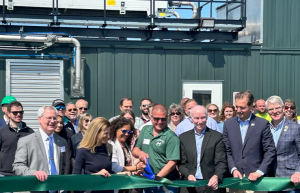Rashi Akki launched Ag-Grid Energy LLC in 2016, with a vision for simultaneously improving the viability and financial stability of American dairy farms through the carbon-negative production of renewable biofuels from cow manure and food waste. Currently, Ag-Grid has five operating dairy digesters that process both dairy manure and food waste. Two of the digesters, located in Connecticut, produce renewable electricity, reducing the carbon footprint of dairy farms and adding to the electrical grid.

Prior to founding Ag-Grid Energy, Akki worked for the DuPont Chemical Company, where she held senior positions in central R&D, DuPont Titanium Technologies, Nonwovens, and Industrial Biosciences. Akki earned her B.S. degree in chemical engineering from Osmania University in India, her M.S. degree from University of Connecticut, and her Ph.D. from Georgia Institute of Technology. She is a member of the American Biogas Council, and Partnership for Electric Pathways. She was inducted into the UConn Academy of Distinguished Engineers in 2024.
You started your university education in India before coming to America. How difficult was that transition?
I was motivated to come to the United States while I was in undergrad – many classmates around me, particularly in the university community, were talking about emigrating to America. I knew of UConn through a colleague at Osmania who had come to Storrs to get his master’s degree. In 1988, I moved to the U.S. and came straight to UConn. Assimilation took some time, as you might imagine… back home, I was very traditional and had never even worn a pair of blue jeans.
I had long hair and wore ethnic garb. After a few months, an advisor recommended that I try to adapt to U.S. culture. It was good advice, even though I cherished my heritage. I chopped my hair, bought jeans, and worked at reducing or removing cultural barriers, which was a good move, at least appearance wise! The education system here was so different from back in India; I had never used a mainframe computer or graphing tools, and really dove into data analysis and experimentation.
What did you study at UConn?
I have to admit I fell in love with research when I was at UConn, and spent the next decade in research because of that exposure. I was really interested in polymers, and after earning my master’s degree, worked in polymers for the next 20 years. My experiences there helped me develop an in-depth understanding of science, and I still use those fundamentals today. I hadn’t thought about earning a Ph.D., but was driven by the idea of putting science into action.
How did your work at DuPont lay the groundwork for your current vocation?
Of my 20 years at DuPont, 15 were in polymers. I was very interested in chemistry and chemistry-related work, and expanded into business management and product development, areas that would be critical to starting my own business. When I became immersed in industrial bioscience, I was sent to Europe to see how companies there were utilizing enzymes to improve biogas production on dairy farms. I spent a lot of time in Italy and Germany, visiting small dairy farms, typically those with fewer than 200 cows. Each of the farms I visited had anaerobic digesters, which I found fascinating. They were able to use these systems to produce energy, reduce carbon, and rid themselves of methane.
How did this all translate to you starting Ag-Grid Energy LLC?
After visiting many of those farms and companies in Europe, I did more research and realized that some U.S. farms were using anaerobic digesters, but not many. I decided I wanted to build my own digester, rather than remain in a corporate setting; I knew I wanted to be my own boss, and be able to take risks.
I started talking to farmers, and by the end of 2016, had identified four dairy farms that were willing to work with me. I recognized that these farmers were partners, not just clients, and that collaboration was critical to creating a dynamic entity that could be successful and sustainable.
There was a lot to learn, especially about financing and investors. I had to create a new business model that would allow investment in this field, and become knowledgeable about engineering, prospective builders and vendors, utilities, permitting, grants and much more. I literally had to claw my way up in the beginning, and finally found a bank that would help with financing, and a tax credit partner.

What happened next?
Well, from research to my first groundbreaking took two and a half years. By June 2019, I was up and running with two projects in Western Massachusetts. At that time, there weren’t any digesters in Connecticut, so I brought my Massachusetts team with me to Connecticut and was able to obtain partial funding through the Connecticut Green Bank.
It’s funny, you’d think something this practical, a science that makes so much sense, wouldn’t be so innovative or hard to finance. But this technology is more expensive to implement than are solar or wind, so funding is a challenge. Several states had food waste bans – that supported the new business model. In New England, the farms are small – the manure their cows produced wouldn’t be enough to create the extra energy needed to self-sustain and sell back to the grid, so the innovation became adding food waste to create that extra energy. I was able to gather food waste from food processing plants and grease trap waste from fast-food chains, and divert these to our project. Besides processing the waste and creating electricity, we also were enhancing nitrogen and phosphorus in remaining digestate, which are used in fertilizers on the crop farms where the dairy farmers produce feed for their cows.
Are your tanks for the digesters bigger than a breadbox?
Oh, my yes – we’re talking about million-gallon tanks buried underground, 120 feet in diameter and 20 feet deep. We also built covered lagoons or large concrete storage tanks to store the digestate which is rich in organic fertilizer. This process offers efficiency, heat, cogeneration and enhanced nutrient benefits. The heat is piped to areas of the farm and used to prevent icing in the barns and garages, and we’ve been able to reduce the farmers’ need to buy other fuels at our projects in Connecticut, Massachusetts and in New York.
What’s next for you and Ag-Grid?
Well, we recently broke ground on a new project in Michigan, which will include piped renewable natural gas, which is a new addition to our portfolio. We’re looking at larger farms, and now have 10 employees. We’ve become more technologically savvy as well, and use sophisticated sensors for remote monitoring and to help us analyze and then control feed digesters online. We’ll continue looking into “right sizing” our projects for maximum efficiency and profit for our customers, as well as the production and refining of chemical intermediates such as methanol and marine fuels.
We try to avoid energy politics – our interest is in helping farmers rebuild rural America by offering them ways to keep costs down, reduce their environmental footprint and remain good conservation stewards.
What lessons can you share from your experiences?

I can offer three insights. First, research and learning at UConn helped transform my thinking and vision. It’s critical to come to your studies with an open mind, and be willing to explore, experiment and take risks. One of the beauties of being in college is remaining nimble and trying to figure out how you can fit in the changing and new world order.
Second, balance is important. For me, a huge driver was finding the balance between creating a successful business and doing the right thing. It’s not just about making money – if you keep the greater good in mind, like the importance of protecting the environment, while at the same time helping sustain small farms, that balance will likely result in greater success.
That balance also includes personal needs and time. I live in Pennsylvania, have three children, love painting and reading, and find time to give back by being a director on my local school board, helping our schools make smart choices and decisions.
And finally, you need to know who you are, or to figure that out as you grow. I realized that big business wasn’t for me, that I was better suited to be a small business owner and entrepreneur. Carve your own path… find the passion that fits your personality and know that success – and the money – will come.



